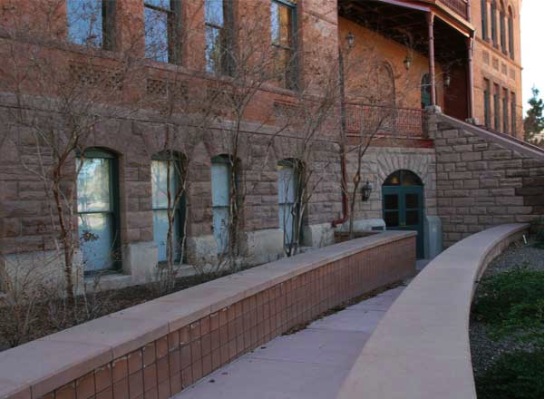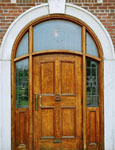Rosalynn Voaden
Teaching CanLit in Arizona

Old Main Building, Arizona State University ©Rishma Dunlop
“Canada? Cold up there, isn’t it?” After several years in exile in the Arizona desert, I had had enough of being unable to get Canadian novels on Amazon.com and of the assumption that Margaret Atwood is the only Canadian writer. I am a medievalist by training, but I decided to try to make at least a few undergraduates aware of the nation to the north, and of its vibrant literature. So, four years ago, I offered an introductory course in Canadian Literature, titled “Sex, Death and Snow” (yes, I know I’m perpetuating the stereotype - but at least I’ve expanded it). My goal was to give students some basic knowledge of Canada and to have them read a variety of representative works. I chose works which offer chronological and geographical range, and focused mainly on the impact of the Canadian environment on its literature. Writers included Frederick Philip Grove, Jane Urquhart, Margaret Atwood, and Joseph Boyden.
My course has benefitted greatly from the presence of a Canadian Fulbright Writer in Residence at Arizona State University every spring semester for the past five years. Writers Rishma Dunlop, Warren Cariou, Alison Calder, Ross Leckie, and Tom Wayman have visited my class and made it possible for the students to talk with real, live Canadian writers and hear them read from their works. The course has become very popular; this year it filled the day that registration opened.
While I have been able to create a little oasis of Canadian Culture among the cacti for three hours a week, I have become very aware of the difficulty, and responsibility, involved in conveying a balanced portrayal of a different country through its literature. The students enjoy their brief immersion in another culture, and find Canada interesting. Several have made plans to visit, and one has even applied for a Killam Exchange Fellowship. Yet I know, as they don’t, that their perception of Canada and its literature is limited, and that their understanding is shaped by the works I have chosen. Sometimes I fear that they now think of Canada as a place peopled by monosyllabic Scandinavian immigrants, frustrated women, and comatose Cree bush pilots. But I console myself with the thought that at least they know that there is compelling literature north of the US border - and that it isn’t cold there all the time.
.
In Spring 2010, my students wrote a collaborative, lyric essay about their reading experiences in English 294. In the words of Jourdan Hercsek, one of my students who edited this class essay: “The intent of the piece was to chronicle our experience of reading Canadian literature while residing in Arizona, most notably the emotional and literary journey that we all took while reading some of the most renowned Canadian novels of the contemporary era. It draws upon the idea that while the novels created a beautiful world for us to inhabit as we read them, we still felt like our true understanding of Canada was crippled due to our desert location. Throughout the essay there are several references or mentions of characters, settings, and motifs from the novels we read (The Diviners, Settlers of the Marsh, The Apprenticeship of Duddy Kravitz, The Blind Assassin, Away, and Through Black Spruce).”
I am pleased to introduce English 294, Spring 2010 authors of “Sex, Death and Snow: Reading CanLit in Arizona,” Editors: Jourdan Hercsek; Allison Walsh; Keiaunna Cantley, and Kristin Smith. Contributors: Rachel Adams; Stacy Bennet; Scott Eby; Veronica Engler; Alexandra Goodspeed; Kyle Johnson; Devan Manning; Patrick McHugh;Giorgio Mosesso; Ashleen Piercy; Samuel Rugeris; Charles Santoli; Kendra Schmid, and Kari Sleezer.
Rosalynn Voaden
Arizona State University
My course has benefitted greatly from the presence of a Canadian Fulbright Writer in Residence at Arizona State University every spring semester for the past five years. Writers Rishma Dunlop, Warren Cariou, Alison Calder, Ross Leckie, and Tom Wayman have visited my class and made it possible for the students to talk with real, live Canadian writers and hear them read from their works. The course has become very popular; this year it filled the day that registration opened.
While I have been able to create a little oasis of Canadian Culture among the cacti for three hours a week, I have become very aware of the difficulty, and responsibility, involved in conveying a balanced portrayal of a different country through its literature. The students enjoy their brief immersion in another culture, and find Canada interesting. Several have made plans to visit, and one has even applied for a Killam Exchange Fellowship. Yet I know, as they don’t, that their perception of Canada and its literature is limited, and that their understanding is shaped by the works I have chosen. Sometimes I fear that they now think of Canada as a place peopled by monosyllabic Scandinavian immigrants, frustrated women, and comatose Cree bush pilots. But I console myself with the thought that at least they know that there is compelling literature north of the US border - and that it isn’t cold there all the time.
.
In Spring 2010, my students wrote a collaborative, lyric essay about their reading experiences in English 294. In the words of Jourdan Hercsek, one of my students who edited this class essay: “The intent of the piece was to chronicle our experience of reading Canadian literature while residing in Arizona, most notably the emotional and literary journey that we all took while reading some of the most renowned Canadian novels of the contemporary era. It draws upon the idea that while the novels created a beautiful world for us to inhabit as we read them, we still felt like our true understanding of Canada was crippled due to our desert location. Throughout the essay there are several references or mentions of characters, settings, and motifs from the novels we read (The Diviners, Settlers of the Marsh, The Apprenticeship of Duddy Kravitz, The Blind Assassin, Away, and Through Black Spruce).”
I am pleased to introduce English 294, Spring 2010 authors of “Sex, Death and Snow: Reading CanLit in Arizona,” Editors: Jourdan Hercsek; Allison Walsh; Keiaunna Cantley, and Kristin Smith. Contributors: Rachel Adams; Stacy Bennet; Scott Eby; Veronica Engler; Alexandra Goodspeed; Kyle Johnson; Devan Manning; Patrick McHugh;Giorgio Mosesso; Ashleen Piercy; Samuel Rugeris; Charles Santoli; Kendra Schmid, and Kari Sleezer.
Rosalynn Voaden
Arizona State University













